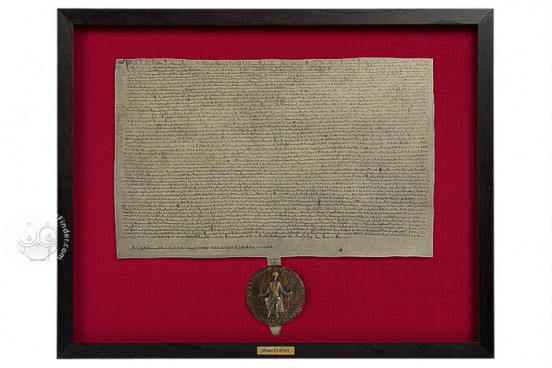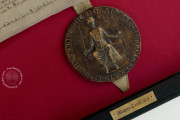In the days before midsummer of 1215, King John I of England met with his church officials and nobles in a field called Runnymede to broker a peace with a group of rebel barons. The resulting document was called the Magna Carta Libertatum, the Great Charter of the Liberties. It defined the rights of the English people in the feudal system, from the lowest serf to the king himself, and set limits on the power of the crown.
Although the Magna Carta of 1215 failed in brokering a lasting peace, it served as the basis for later versions issued under subsequent kings and thus is considered a foundational document for the establishment of human rights. It is one of the most well-known single documents of the medieval period with a lasting legacy for Western democracy.
The text is in heavily abbreviated Latin without decoration or illumination. This early version is without demarcated clauses. The entire text is written as a single block across the width of the parchment. Additions in the margins suggest amendments to the document even as it was being drafted.
One of Four Known Exemplifications
Four exemplifications of the 1215 issuance are known to exist. This one is the only copy written in landscape format. Slices at the bottom of the single sheet of parchment indicate the attachment of a now-lost royal seal. The script is protogothic documentary, likely written by a royal or church scribe in attendance at Runnymede.
The document is written in a single hand in brown-black ink without any ornamentation excepting the standard elaboration of capital lettering. Around thirteen exemplifications were issued; copies would have been sent to centers of political and ecclesiastic power. Two of the four known copies remain at Salisbury Cathedral and Lincoln Cathedral.
“To No One Deny or Delay Right or Justice”
The content of the Magna Carta focuses on the relationship between the monarchy and the barony rather than reaffirming the rights of the common people, however the myth of the document shaped the course of world history so profoundly that the idea of the Magna Carta is perhaps more important than its actual text.
But its restrictions on the king set the stage for a different vision of monarchy that would see England diverge from its continental neighbors and inspire rebellions through the seventeenth and eighteenth centuries. Three of its clauses remain active in English Law to this day.
From a Tailor’s Shop to the British Library
This copy was part of Sir Robert Cotton’s library of ancient manuscripts that was given to the British public and formed the foundation of the British Library’s manuscript holdings. He was given the document by the lawyer Humphry Wyems, who may have obtained it from a tailor’s shop.
We have 1 facsimile edition of the manuscript "Magna Carta": Magna Carta facsimile edition, published by The Folio Society
Request Info / Price

